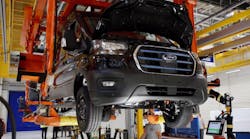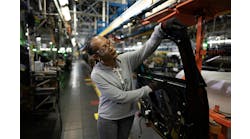Ford Motor Co.’s leaders say that, despite a disappointing set of fourth-quarter results and supply-chain problems that are hurting sales early in 2022, the auto giant will ramp up production by more than 10% this year and grow its adjusted pretax profits by 15% to 25%.
Dearborn, Michigan-based Ford reported a net profit of $12.3 billion on sales of $37.7 billion, with the company’s adjustment of the value of its stake in electric truck maker Rivian creating a $9.6 billion one-time gain. Per share, adjusted profits missed analysts’ expectations. Adjusted earnings before taxes and interest were $2.0 billion for the quarter, up from $1.7 billion in late 2020, and $10.0 billion for the full year versus $2.5 billion in 2020.
For 2022, President and CEO Jim Farley and his lieutenants are forecasting that that EBIT number will grow to between $11.5 billion and $12.5 billion, powered in part by continued strong pricing thanks to sticky demand. Capital spending for the year is expected to be between $7 billion and $8 billion versus $6.2 billion in 2021. Suppliers’ troubles with COVID-19 and semiconductors caused Q4 production to fall 11% and are expected to have first-quarter sales come in 10% below the levels of early ’21 but Ford’s leaders—echoing General Motors Corp.’s Mary Barra—see them easing as the year progresses.
Farley and his team have in recent months made headlines with announcements about scaling up their push into battery electric vehicles. They will this spring bring to market the electric F-150 Lightning and plan to make 600,000 BEVs in 2023. Ford finished 2021 with reservations for more than 275,000 Mustang Mach-E sport utility vehicles, F-150 Lightning pickups and E-Transit commercial vans.
On a Feb. 3 conference call with analysts and investors, Farley noted he and his team are increasingly recognizing the many ways in which Ford’s legacy internal combustion engine business is different from building EVs. Those learnings, he said, are setting the stage for the company to significantly boost EV profits over time by becoming markedly more efficient—by streamlining designs and reducing the number of needed parts, for instance—beyond merely scaling production.
“If I showed you our cooling system for the Mach-E, it has four motors [that] probably needs to be two. It has 60 or 70 hoses; probably needs to be one-third of that,” Farley said. “Those are the opportunities we're going after. And we are not going to wait for next year. We're not going to wait for a minor change. We are going to re-engineer that vehicle now and then use that expertise for Lightning, E-Transit and, of course, all our electric platforms.”
At the same time, he and CFO John Lawler said, the company still expects to steadily grow its ICE business’ margins to help fund its EV investments. Lawler noted that higher-quality manufacturing helped lower Ford’s 2021 warranty costs by $1.4 billion from the year prior and that the company is lowering the costs of connected-car technologies.
Shares of Ford (Ticker: F) fell 4% to roughly $19 in after-hours trading Feb. 3, adding to losses of more than 3% during the regular session. Over the past six months, they’re still up more than 60%.




